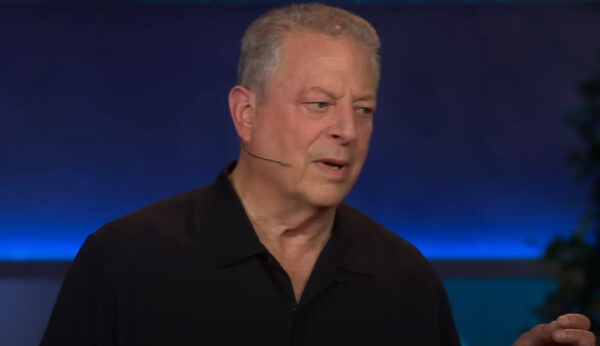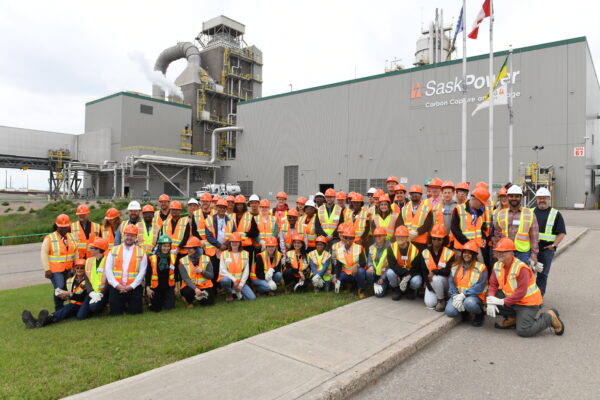
If you haven’t seen Al Gore’s most recent TED Talk, it’s well worth it for the entertainment alone.

If you haven’t seen Al Gore’s most recent TED Talk, it’s well worth it for the entertainment alone.

Are the federal Clean Electricity Standards, brought in by Steven Guilbeault and Jonathan Wilkinson, impossible to meet? Pipeline Online asked SaskPower.
“The CER would require SaskPower to effectively rebuild our entire power system, through retiring the majority of our existing generating units and replacing them with new, ultra-low emitting units or non-emitting energy sources, while also growing the system to support expanding electricity needs that are expected to support growing demand for clean electricity for industrial needs, transportation, increased customer participation and other needs.”

Clean Electricity Regulations released: carbon capture needed for continued fossil fuel power generation. #Saskatchewan will not “defy the laws of thermodynamics,” says Premier Scott Moe.
I still need to dig deep into this. I’ve sent a list of questions to SaskPower and the provincial government seeking response next week, as this dropped just as we’re packing to head to the cabin. Because of course they would release it during the dog days of August.
Note: these regulations expect the electrical grid demand to grow by 2.5x in 26 years, three months and 21 days. Good luck with that. Expect a column next week.
Ever want to see the other team’s playbook? Project of the Century (report link)– the most comprehensive discussion of energy transition we’ve seen to date, was published by the Public Policy Forum. It’s principally about doubling the electrical grid, or more, but doing so without increasing fossil fuel emissions. The dollar figure is up to $1.7 trillion – with a ‘t’ – mostly from federal taxpayer dollars.
Here’s the story on it: https://pipelineonline.ca/project-of-the-century-the-most-comprehensive-discussion-of-energy-transition-weve-seen-to-date/
This is the closest I’ve seen to what the federal Liberal government is trying to accomplish with the “energy transition.” Some of Natural Resources Minister Jonathan Wilkinson’s speech and discussion in Regina and Kipling at the end of June was almost word for word from this paper, before the paper was published.
This has huge implications for Saskatchewan and Alberta. Part of the interview focuses on how net zero by 2035 is impossible.
I spoke to the CEO and one of the authors on July 26. Here’s the in-depth interview. I’ll next be posting an analysis by Jim Warren on this, then likely one of my own.
Editor’s note: Pipeline Online has requested permission from the Public Policy Forum to publish the entire Project of the Century report, in serial form. That permission has not yet been granted, despite the Public Policy Forum’s webpage copyright notice stating, “The Public Policy Forum encourages interested parties to use, in whole or in part, its publications, data, images and other content to further dialogue on public policy in Canada. We require that the PPF is properly cited and acknowledged. In all instances, the PPF would like to be notified of the use of its publications and data.”
They won’t give me a straight answer as to why they won’t let me publish it, when that is clearly their policy. Wonder why that is?
Update Aug. 8, 2023, 10:30 a.m. Since Pipeline Online made the above request, Public Policy Forum has updated its copyright notice. It now states, “Copyright – The Public Policy Forum retains copyright of our publications. For permission to publish a report excerpt, please contact us at: ppforum@ppforum.ca“

So back when the US military was trying to make an ice base like the Planet Hoth from Empire Strikes Back (really happened, 20 years before the movie), they drilled an ice core and hit paydirt. Someone finally got around to looking at that dirt, and it has some startling revelations about the Greenland ice sheet. And when you add that up with what CO2 levels were, something does not jive. And then the mental gymnastics by the media and researches around this are even more entertaining.
Perhaps the science isn’t settled, after all?

Open letter: CCS is needed and ready to address climate change. This is from the Regina-based International CCS Knowledge Centre.
In response to some of the comments yesterday – carbon capture, as practiced in Saskatchewan, actually has a substantial benefit besides whatever climate issues one might be concerned about. The Weyburn Unit, one of the largest and most prolific oil plays in this country, has been in operation for 65 years. If it had no CO2 injection, it would probably be producing around 6,000 barrels per day. It’s currently doing around 24,000 as a direct result of CO2-enhanced oil recovery. That’s a gain of around 18,000 bpd. At $75/bbl., that’s about $1.3 million per day in gross revenue. It means hundreds of jobs in Weyburn, including my daughter, who started working as a heavy duty mechanic apprentice for an oilfield service company which has been working in the Unit for 62 years. If the CO2 continues to flow, that oilfield is expected to continue on likely for her entire career, if she stays there.
This can be applied on a much broader scale, dramatically extending the life of any oilfield it is applied to. CO2 increases recovery factors from around 20% to 40%+.
Just pumping CO2 into the ground – that’s another story.

Why? Because we are the leaders, worldwide. Every second year the IEAGHG summer school returns to Regina and Estevan, because we’ve got the most significant, commercial-scale carbon capture facility on a coal plant in the world, and we’ve learned a lot from it. That’s from the general manager of the IEAGHG.
Say what you want about carbon capture and storage, but Saskatchewan’s a big deal in this field.
I also asked him about when the glaciers covered Canada, and it wasn’t my SUV or the two coal fire power plants near my house that caused them to melt.

The Clean Electricity Standard discussion paper, released a little over a year ago, says, “A Canada-wide CES will complement carbon pricing by requiring the phase-out of all conventional fossil fuel electricity generation.”
And “Regulations to limit fossil fuel generation must be decisive and swift enough to prevent locking in new fossil fuel infrastructure that will persist beyond 2035.”
Also “As natural gas currently plays a critical role in the electricity sector by providing fast-response power, exploration of the continued operation of natural gas assets in special circumstances may be needed. This includes providing flexibility to essential uses of natural gas, such as for emergency events, back-up power to complement variable renewables, and potentially supplying power during seasonal peaks of demand.”
But I asked federal Minister of Natural Resources about this twice between Wednesday and Thursday, and got a different response. He appeared to be open to the continued usage of natural gas power generation, as long as it was coupled with carbon capture. This is a huge deal for Saskatchewan and Alberta, but means expensive CCUS schemes. It could also have national unity implications. Steven Guilbeault even threatened Scott Moe with jail time.
He even said coal with CCUS would be allowed.
Did the feds just blink?
And note: the morning of Wednesday, Alberta’s 3618 megawatts of wind power was producing 3, less than one-tenth of one per cent.

Entitled “Creating a Fair and Equitable Energy Transformation,” The 56 page report outlines nothing short of the utter transformation of Canada, its economy and workforce, by way of transitioning away from fossil fuels to a largely electric economy, with the possibility of hydrogen usage as well. In doing so it means to largely do away with the fossil fuel industry which is one of Canada’s largest industries and contributors to GDP, exports and wealth. The report provides recommendations as to what to do with the people involved in that industry, but not so much the companies who employ them, create those jobs or that wealth.
On Thursday, I’ll have the detailed Conservative response from MP Shannon Stubbs.
Late on Monday the federal Natural Resources Committee released its final report on the “just transition.” Pipeline Online will have several stories on it over the coming days, but the first is the verbatim 19 recommendations by the committee. Both the Conservatives and Bloc issued dissenting reports.
One of the things all this just transitioning is all about is switching from coal, oil and gas to wind and solar. Well, today, the day before the solstice, solar power in Alberta at noon was producing half its rated capacity.

The irony is the current federal government wants to shut this all down, because coal is evil.
In the meantime, Saskatchewan – Regina, Estevan and Weyburn – showed off its decades of experience to worldwide experts on carbon capture, utilization and storage as they set international standards for the same.
The new CEO of Cenovus, Canada’s second largest oil producer and Saskatchewan’s largest (after they bought Husky during the COVID pandemic), tells it like it is. There’s a healthy dose of reality in his comments, but Cenovus is also leading the charge for carbon capture in the oilsands. He also likes the idea of nuclear reactors usage in the oilsands.
 Saskatchewan’s own Quick Dick McDick offers his take on federal Minister of Environment and Climate Change Steven Guilbeault. He talks about the implicit threat of criminal sanctions for keeping the power on, and how Guilbeault should know a thing or two about wearing handcuffs. Quick Dick picks up on a lot of the stuff I’ve been writing about recently.
Saskatchewan’s own Quick Dick McDick offers his take on federal Minister of Environment and Climate Change Steven Guilbeault. He talks about the implicit threat of criminal sanctions for keeping the power on, and how Guilbeault should know a thing or two about wearing handcuffs. Quick Dick picks up on a lot of the stuff I’ve been writing about recently.
The Saskatchewan Legislature ended its 2022-23 session on Thursday. The very first bill was about keeping the lights on, and the very last debate was also about keeping the lights on. This was the keeping the lights on session.

This past week the Saskatchewan government spent a lot of time on power generation and this “Net Zero by 2035” idea the federal government is trying to force upon the provinces.
This is the “energy transition” decision making in real time, folks. The impacts are enormous for this province, which is why I’ve been hammering these stories so hard.
The week summed up with Premier Scott Moe coming to Estevan to explain to local officials what the provincial government’s plans are for power production. For generations, Estevan has been home of the highest concentration of power generation in this province. However, the addition of multiple gas plants and wind facilities has largely diluted the percentage of power from Estevan. But as the province is clearly indicating a move towards nuclear, Moe all but said that Estevan will be home to some of the first small modular reactors. Pay attention to how he corrects himself from saying “nuclear” to “small modular reactors.” In this video, Moe addresses many of the concerns I’ve been raising over the last 17 months. As for adoption of nuclear – if future Saskatchewan governments follow Moe’s lead, this won’t be a small thing. Twenty years from now, as all our coal is retired and as older natural gas plants also reach retirement age, it looks like Saskatchewan will be moving to a largely nuclear grid for baseload power. And when Moe says baseload, he repeatedly refers to 80 per cent of the grid. That’s a lot more than four reactors down the road. That’s a sea change.
There’s also response from Estevan Mayor Roy Ludwig on what this all means.

Regarding this impending Clean Electricity Standard, which would force a massive energy transition in Saskatchewan in just 12 years:
Without committing to nuclear, Saskatchewan is pretty much committing to nuclear
Asking Scott Moe: What if the feds order power plants be shut down, and the Supreme Court backs them?

It turns out Steven Guilbeault has an answer for that: He said burning coal would be a violation of Canada’s Criminal Code. So will the feds be arresting the premier, SaskPower minister, SaskPower CEO, coal miners or power plant operators? All the above? And will they be arrested the same way Guilbeault was, when as a Greenpeace protestor, he scaled the CN Tower?

Saskatchewan will not meet Net Zero by 2035, but will aim for 2050. Here’s a lot more depth than you’ll find from any of the other Saskatchewan media. And there’s more to come regarding what this means for federalism. Follow up story is about how we’re going nuclear.

When the SaskPower Boundary Dam 3 carbon capture project opened in 2014, nobody followed. The tech looked doomed as recently as a few months ago. On May 11, the US Environmental Protection Agency proposed that all coal and most natural gas power plants have carbon capture applied by 2038, or shut down.
Interestingly enough, last year, when I asked Crown Investments (and SaskPower) Minister Don Morgan if we would be doing any more carbon capture on coal, he said it was “not an option.” So, in Canada, it’s not an option, but in the US, it looks like it may soon be mandatory.

Is national unity at stake?
SaskPower will be building a new $850 million natural gas power station near Lanigan, starting in under a year. More than half of its power will go to the BHP Jansen potash mine, the crown jewel of Saskatchewan’s economy. But Steven Guilbeault and Justin Trudeau want to shut down all natural gas power stations by 2035.
Irresistible force is about to meet immovable object, and national unity is on the line.
Oh, and for good measure, Bill C-69 is involved.
Will Shand and/or Boundary Dam be converted from coal to gas-fired? No, but SaskPower is looking at it. If they do, that’ll be a whole lot of coal miners and coal processing staff out of work.